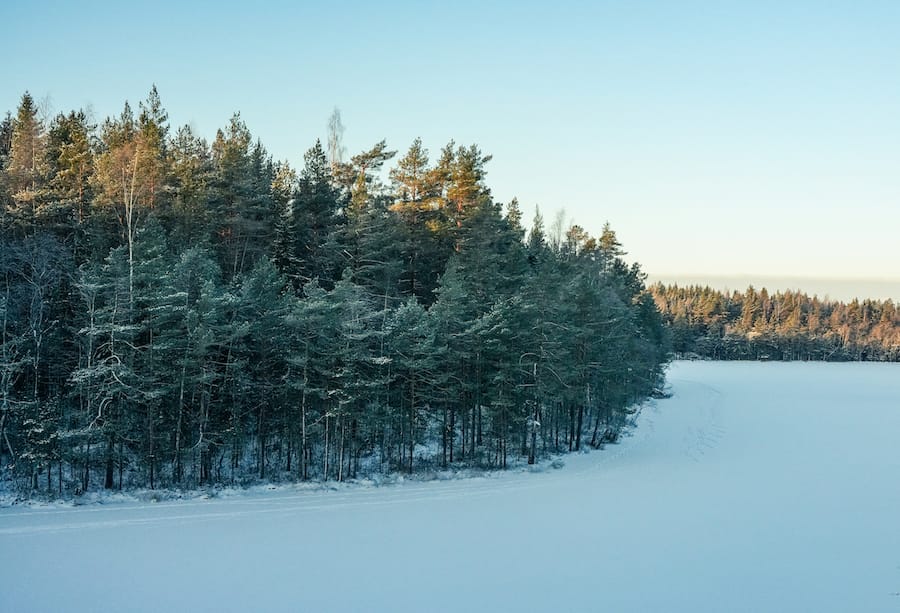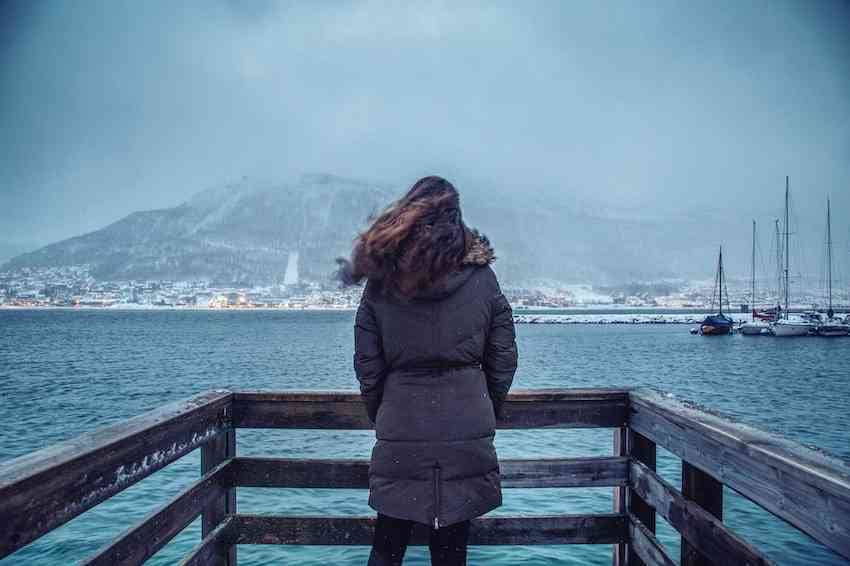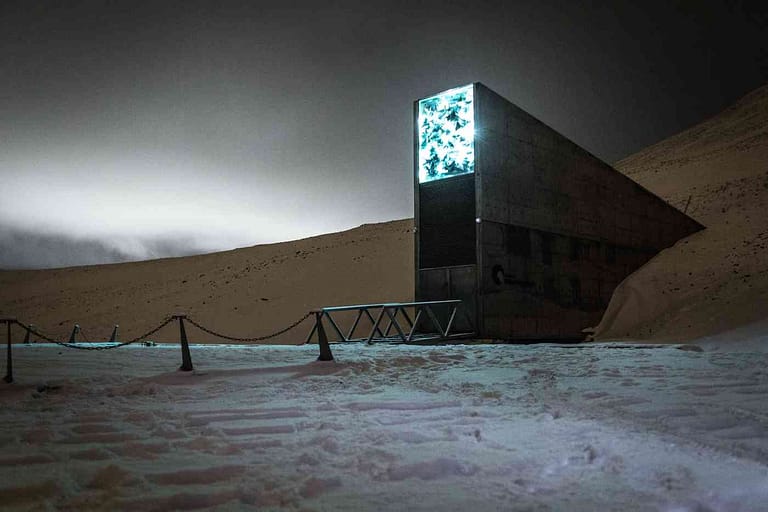COMPLETE Winter Packing List: Cold Weather Gear You Need
If you’re planning a trip to the Arctic Circle, or any frigid winter destination, knowing what to pack can make the difference between having a great experience…or a miserable time freezing in the snow while having your camera repeatedly die on you. To get the best snow gear, clothing, and accessories, read this ultimate winter packing list.
When I was preparing for my trip to Tromsø, Norway and then Svalbard, I realized what I had in my LA closet just wouldn’t cut it. At least if I wanted to retain any body heat whatsoever.
Disclaimer: Lose the Map contains affiliate links and is a member of Amazon Services LLC Associates Program. If you make a purchase through an affiliate link, I receive a small commission at no extra cost to you.
When I got to Norway, I also realized that I had made some mistakes with my winter travel packing list. So I had to do last-minute (expensive) shopping in Norway. No one should ever have to pay Norwegian prices unnecessarily without getting Norwegian incomes.
Learn from my mistakes and make sure you’re prepared for winter travel BEFORE your arrival. So you’re not figuring out what to wear in the arctic when you’re already at 78 degrees latitude in Svalbard.
In addition to the basic winter clothing you would pack anyway, the packing tips below should help you stay warm, comfortable, and most of all, ready for winter trips!
I used it for the Arctic, then for my winter travel to Finland, Estonia, and Latvia, as well. So this serves as a general winter trip packing list. I have included suggestions for the best products to buy for winter travel, including electronics and accessories, clothing, and winter sports gear.
Disclosure: This post contains affiliate links for which, at no additional cost to you, I will earn a small commission if you click through and make a purchase. As an Amazon Associate I earn from qualifying purchases. However, all opinions and recommendations are my own.
Winter Packing – Layers, Layers, Layers
I don’t think I once went out in Norway in under four layers on top, and two on the bottom. Any winter vacation in the far northern reaches of Europe, Asia, or North America, will have the same dress code.
Let’s start with some winter clothes basics for our packing list.
Tip: If you can’t decide on material, merino wool is really comfortable, soft, and good at insulating you.
Thermal Base Layers for Winter Travel
You’re going to want a base layer underneath at all times for winter trips. Unless those trips are to the Bahamas. But for the best clothing for Arctic conditions, you’re in the right place.
I love the Thermajane Long Johns for thermal tights and shirts – it uses special technology for added warmth. If you want to order thermal layers online, you can order the Duofold thermal shirt and Duofold thermal leggings.
Pack an extra pair of thermal shirts and leggings for winter travel because those things will get gross and sweaty fast. You will need to hand wash and alternate.
Tip: Also, never wear the rest of your wool clothes without these layers. Thermal undergarments are sweat wicking; if you don’t wear them, your other clothes will make you sweat like crazy.
Heavy Wool Sweaters
On top of your base layer, you should have a well-fitted long sleeve shirt, and then a heavy sweater. A lot of heavy sweaters can leave room between the fabric and your body, so it’s good to have a more fitted shirt underneath it. The good thing is that, unlike some other items on this list, you probably already have a bunch of sweaters on your hand to pack for a winter trip.
Parka/Coat
This is probably going to be the most expensive item you invest in, but parkas are pretty durable and furthermore, necessary. A regular winter coat won’t cut it for most winter destinations. Opt for a waterproof, long optioned, heavy coat, with a lined hood if possible; you’ll be glad for that extra warmth on your upper legs and head.
If you want some heavy-duty parkas, Arctic Circle winter jackets to keep you warm in the most frigid of destinations, here are some I recommend:
Options for women:
- Arc’teryx Beta Down Parka ($$$)
- Fjallraven Kiruna Padded Parka ($$)
- North Face Gotham Parka ($$)
- North Face Junction Insulated Parka ($)
Options for men:
Winter Boots
A solid WATER RESISTANT pair of winter boots with good traction to prevent slipping and sliding on the ice is indispensable on your Arctic trip. If you can’t choose boots, the Columbia snow boot is great for women, while the Kamik Nationplus boot is a good option for men.
Make sure you choose winter boots that are lined on the inside. This will keep your feet warm and less prone to injuries while you walk around everywhere.
Socks
The right pair of warm socks will make a difference between your feet feeling nice and snug, or your feet feeling nothing at all. Once again, I highly recommend merino wool socks as the way to go. They’re what kept me walking and moving at -10 degrees Celsius in the Baltics.
Gloves
Though you will probably want to find the thickest gloves available, if you’re going to be doing things that require a lot of dexterity (AKA taking photographs), bulky gloves will be a problem on your winter vacation. You’re probably going to end up having to take them off a lot.
If you don’t need your hands to be too flexible, the Carhartt Insulated Gloves work well. If you need more dexterity, try light gloves like the Tomily Touch Screen Gloves.
Scarf
A good wool scarf will really trap the heat in – it’s one piece of cold weather gear for which you’ll really be thankful. It also helps you retain heat, as it stuffs up any space between your neck and the top of your coat, where cold air would otherwise enter.
Winter Hat
Keeping your head warm is of the utmost importance. You could be bundled up all over the rest of your body; if your head is uncovered, you’re going to start freezing soon. Take either a thick wool beanie or knitted winter hat. Make sure whatever you take covers your ears as well, so they can stay warm.
Optional Winter Clothing Items
Snow Pants
If you’re going to be doing a lot of outdoor activities, like skiing, snowmobiling, or dog sledding, snow pants are a good idea to pack as well. The Arctix Insulated Snow Pant is a good affordable option for women; the Arctix Mountain Insulated Ski Pant is great for men. Otherwise, any ski pants you can find also work.
Neck Warmer
I put this under the “optional” list, but I still HIGHLY recommend a neck warmer/face mask. If you want to get this instead of a scarf, that’s perfectly fine. Try the Thermal Insulated Neck Warmer.
Hand Warmers
For photographers who will frequently be using thinner gloves, Yaktrax Hand Warmers can help you retain some heat. Most are little patches you slip into your glove and leave against your palm. Your skin heats them up, and in return, they help you with staying warm.
Arctic Gear and Cameras
Waterproof, Sturdy Backpack
I kept my cameras in a backpack that I ended up having to place in snow banks quite often so I could set up tripods, etc. So top priority on my Arctic packing list was to have a pretty weather-resistant, waterproof backpack.
Even if you’re not a photographer, you can use it to keep extra layers or anything else you may need. The Swiss Ruigor Water Resistant Backpack is one of several great options; pick something that fits your laptop and anything else you may need.
Great DSLR or Mirrorless Camera
A point and shoot camera isn’t going to do much in the low light (or no light) conditions of the Arctic winter. If you want to capture the Northern Lights and your snow-covered surroundings, you need cameras which you can set to take long exposure shots, and cameras where you can bump up the ISO without getting too much noise.
Below are the cameras I use:
DSLR – Canon 5D Mark IV: There is no equivalent to the quality of a DSLR; however, it is more expensive and heavier than most cameras. Also, if you are a novice photographer and aren’t comfortable shooting well in AV or Manual mode, this camera may be challenging.
Mirrorless – Sony α7 III: I love how light and easy to use this Sony mirrorless camera is. I don’t know if I could have captured the Northern Lights shots I got with the DSLR on this, but it did well for most of the other shots I had to take.
Sturdy, Weather-Resistant Tripod
Of all the cold weather gear you need for your camera, a solid tripod is absolutely critical to getting great shots on an Arctic Circle trip.
You will need to take many long exposure shots, and the near-constant wind will interfere with your shots if you use a less-than-sturdy tripod. However, there are plenty of tripods that are sturdy yet lightweight and don’t take up too much space. I use the Benro Aluminum Tripod, and I’m very happy with it.
Wide Angle Lens
In addition to your standard kit lens, a wide angle lens will allow you to take some truly great photos of the epic Arctic Circle landscapes. Plus, a wide angle lens with a low F-stop is highly recommended for Northern Lights shows. I use the Canon 16-35 mm f/2.8 wide angle lens.
Extra Camera Batteries
I recommend packing at least two extra camera batteries for your winter vacation. Battery life is reduced almost 50% in below-freezing weather, and I found my batteries were running out of juice constantly.
Get a couple of Canon batteries or batteries for your camera brand of choice, and be sure to keep them as close to your body as possible (for example: an inside pocket), so the cold doesn’t affect them as much.
Cleaning Cloths for Your Lens
I can’t tell you the amount of photos that I discovered (too late) had drops of precipitation obscuring some stunning Arctic vistas. It snows A LOT.
You will regularly be taking photos while flurries fall all around you. Stock up on MagicFiber cleaning cloths for your camera lens to make sure this doesn’t affect your photography. You don’t want to photograph all these winter wonderland landscapes and end up with a bunch of spotty photos.
What NOT To Pack for the Arctic Circle

The fact is, any complete packing list for winter, no matter how well thought out, is going to result in a bulkier suitcase than you’re used to carrying.
Winter clothing and cold weather gear takes up a lot more space than packing for a tropical getaway, unfortunately. To keep your suitcase to a manageable weight, here are some things you definitely do NOT need to pack.
Any Shoes Beyond 2 Pairs of Boots
I seriously doubt there is any occasion for which you will need heels, fashionable flats, or anything of that kind. Pack just one pair of boots and wear another pair on the flight to save on space – you don’t need anything more. I recommend two pairs JUST IN CASE something happens to one pair.
More Jewelry and Accessories Than What You Wear on the Flight
98% of your skin will be covered up at all times. Necklaces and bracelets won’t be visible for the most part. Wear whatever you like on the flight and stick with it – no need to add more weight to your bag for accessories people can’t see.
Use Packing Cubes
It may be hard to pack light, but with packing cubes, you can separate your layers to make getting dressed easier.
Put your base layers, top layers, and other winter clothes in separate cubes. This will keep your winter travel gear separate, easy to find, and less likely to make other clothes dirty.
When I did this for my six-day Baltic tour, I was able to fit everything into my carry on for a few days. The secret is, you just have to wear all your bulky items on the plane – parka, the biggest insulated boots you have, etc.
Winter Travel Checklist
If you want to pack for a winter vacation, I compiled the info in this post in this quick, easy-to-use checklist. Use it to check that you’ve packed all the winter travel essentials you will need to stay cozy.
If you liked this post and want to share, Pin away below!
Have you been to the Arctic Circle in winter? What do you recommend packing? Comment below!


















Wonderful tips. I will be planning my trip soon to arctic and your accessories ideas are perfect. I will also put some of my leather protection gear with me. Thanks a lot.
No problem! Glad I could help :) Have a wonderful trip!
Playing in the snow is something that is enjoyed by many. If you like skiing or riding a snowmobile, then consider adding a track that can make going through the snow much easier.
Amazing ideas for snow fall.